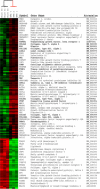Post-epidemic eosinophilia-myalgia syndrome associated with L-tryptophan
- PMID: 21702023
- PMCID: PMC3848710
- DOI: 10.1002/art.30514
Post-epidemic eosinophilia-myalgia syndrome associated with L-tryptophan
Abstract
Eosinophilia-myalgia syndrome (EMS) is characterized by subacute onset of myalgias and peripheral eosinophilia, followed by chronic neuropathy and skin induration. An epidemic of EMS in 1989 was linked to consumption of L-tryptophan that had originated from a single source. Following the ban by the Food and Drug Administration (FDA) on the sale of L-tryptophan, the incidence of EMS declined rapidly. Moreover, no new cases have been described since the FDA ban was lifted in 2005. We report the clinical, histopathologic, and immunogenetic features of a new case of L-tryptophan-associated EMS, along with evidence of activated transforming growth factor β and interleukin-4 signaling in the lesional skin.
Copyright © 2011 by the American College of Rheumatology.
Figures



Similar articles
-
L-tryptophan and the eosinophilia-myalgia syndrome: current understanding of the etiology and pathogenesis.J Invest Dermatol. 1993 Jan;100(1):97S-105S. doi: 10.1111/1523-1747.ep12356368. J Invest Dermatol. 1993. PMID: 8423409 Review.
-
Tryptophan toxicity: a pharmacoepidemiologic review of eosinophilia-myalgia syndrome.DICP. 1991 Nov;25(11):1259-62. doi: 10.1177/106002809102501116. DICP. 1991. PMID: 1763543 Review.
-
[A case of the eosinophilia-myalgia syndrome].Ryumachi. 1992 Aug;32(4):327-30; discussion 330-2. Ryumachi. 1992. PMID: 1411794 Japanese.
-
L-tryptophan-related eosinophilia-myalgia syndrome possibly associated with a chronic B-lymphocytic leukemia.Ann Hematol. 1998 Nov;77(5):235-8. doi: 10.1007/s002770050449. Ann Hematol. 1998. PMID: 9858150
-
Tryptophan produced by Showa Denko and epidemic eosinophilia-myalgia syndrome.J Rheumatol Suppl. 1996 Oct;46:81-8; discussion 89-91. J Rheumatol Suppl. 1996. PMID: 8895184 Review.
Cited by
-
Severe eosinophilic syndrome associated with the use of probiotic supplements: a new entity?Case Rep Rheumatol. 2012;2012:934324. doi: 10.1155/2012/934324. Epub 2012 Dec 6. Case Rep Rheumatol. 2012. PMID: 23259129 Free PMC article.
-
Risk factors and disease mechanisms in myositis.Nat Rev Rheumatol. 2018 Apr 20;14(5):255-268. doi: 10.1038/nrrheum.2018.48. Nat Rev Rheumatol. 2018. PMID: 29674613 Free PMC article. Review.
-
Morphea and Eosinophilic Fasciitis: An Update.Am J Clin Dermatol. 2017 Aug;18(4):491-512. doi: 10.1007/s40257-017-0269-x. Am J Clin Dermatol. 2017. PMID: 28303481 Free PMC article. Review.
-
Environmental risk factors of systemic sclerosis.Semin Immunopathol. 2015 Sep;37(5):463-73. doi: 10.1007/s00281-015-0507-3. Epub 2015 Jul 4. Semin Immunopathol. 2015. PMID: 26141606 Review.
-
Insomnia in Elderly Patients: Recommendations for Pharmacological Management.Drugs Aging. 2018 Sep;35(9):791-817. doi: 10.1007/s40266-018-0569-8. Drugs Aging. 2018. PMID: 30058034 Review.
References
-
- Hertzman PA, Blevins WL, Mayer J, Greenfield B, Ting M, Gleich GJ. Association of the eosinophilia-myalgia syndrome with the ingestion of tryptophan. N Engl J Med. 1990;322:869–73. - PubMed
-
- Silver RM, Heyes MP, Maize JC, Quearry B, Vionnet-Fuasset M, Sternberg EM. Scleroderma, fasciitis, and eosinophilia associated with the ingestion of tryptophan. N Engl J Med. 1990;322:874–81. - PubMed
-
- Swygert LA, Back EE, Auerbach SB, Sewell LE, Falk H. Eosinophilia-myalgia syndrome: mortality data from the US national surveillance system. J Rheumatol. 1993;20:1711–17. - PubMed
-
- Eosinophilia-myalgia syndrome and L-tryptophan-containing products--New Mexico, Minnesota, Oregon, and New York, 1989. Centers for Disease Control (CDC) MMWR Morb Mortal Wkly Rep. 1989;38:785–8. - PubMed
-
- Belongia EA, Hedberg CW, Gleich GJ, et al. An investigation of the cause of the eosinophilia-myalgia syndrome associated with tryptophan use. N Engl J Med. 1990;323:357–65. - PubMed
Publication types
MeSH terms
Substances
Grants and funding
- R01-HG-004499/HG/NHGRI NIH HHS/United States
- R01 AR042309/AR/NIAMS NIH HHS/United States
- U01 AR055063/AR/NIAMS NIH HHS/United States
- R56 AR042309/AR/NIAMS NIH HHS/United States
- R01 AR049025/AR/NIAMS NIH HHS/United States
- AR-42309/AR/NIAMS NIH HHS/United States
- U01-AR-055063/AR/NIAMS NIH HHS/United States
- R25-CA-134286/CA/NCI NIH HHS/United States
- Z01 ES101074/ImNIH/Intramural NIH HHS/United States
- Z01-ES-101074/ES/NIEHS NIH HHS/United States
- R25 CA134286/CA/NCI NIH HHS/United States
- R01-CA-077485/CA/NCI NIH HHS/United States
- R01 HG004499/HG/NHGRI NIH HHS/United States
LinkOut - more resources
Full Text Sources
Molecular Biology Databases

